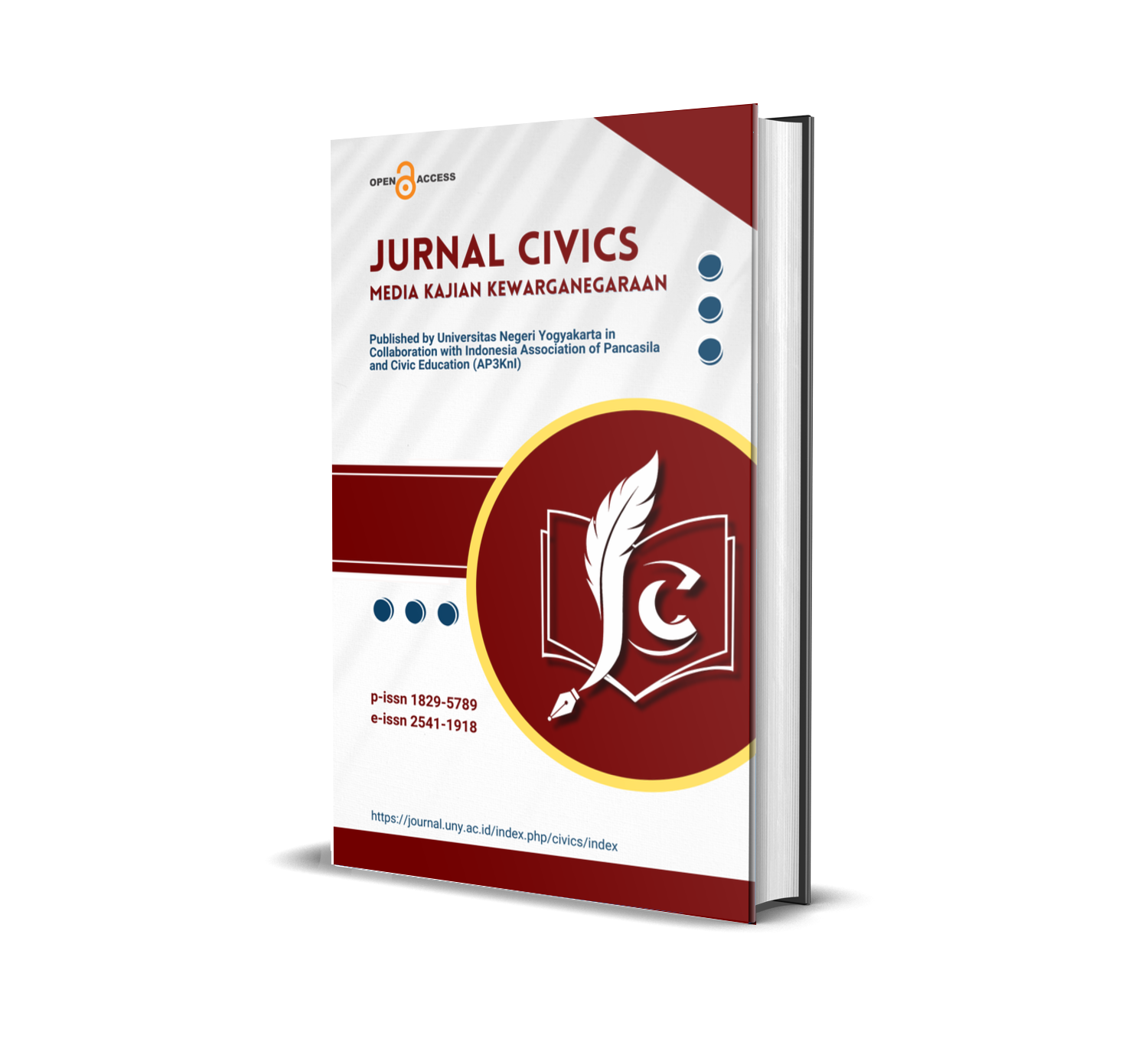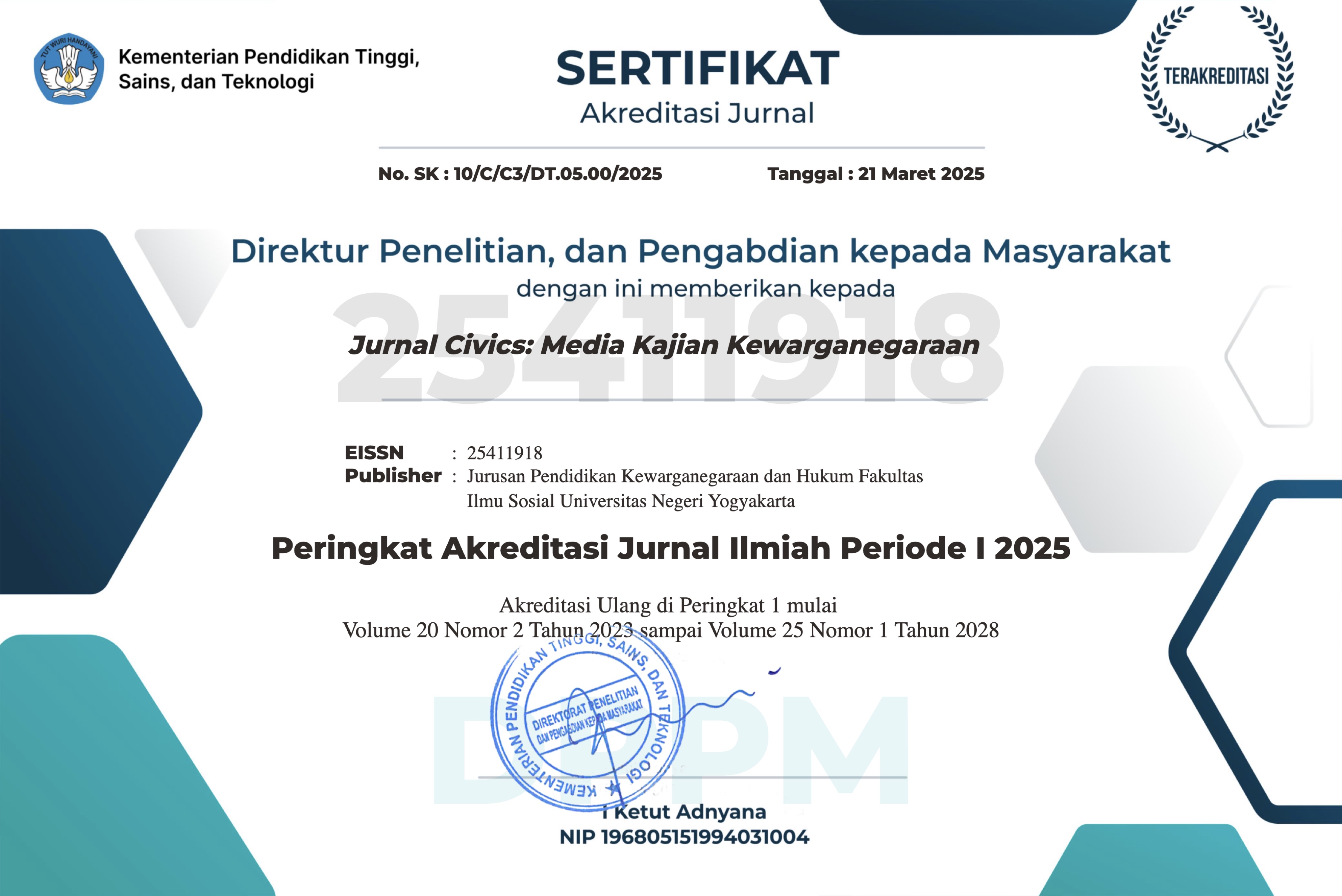Enhancing student creativity through online learning: A study of SPADA Indonesia in Civic Education courses at Universitas Pendidikan Indonesia and Universitas Lambung Mangkurat
Keywords:
Civic Education, Online Learning, Student CreativityAbstract
References
Allen, I. E., & Seaman, J. (2021). Online learning in the time of COVID-19: A snapshot of institutional responses across 4 countries. Babson Survey Research Group.
Barnes, & Noble. (2019). The impact of technology on learning and development. Educational Technology Publications.
Braun, V., & Clarke, V. (2006). Using thematic analysis in psychology. Qualitative Research in Psychology, 3(2), 77–101. https://doi.org/https://doi.org/10.1191/1478088706qp063oa
Brett M, & Fischer. (2020). Developing and sustaining creativity: Creative processes in Canadian junior college teachers. Creativity Research Journal, 30(1), 50–58. https://doi.org/https://doi.org/10.1016/j.tsc.2020.100754
Chang, J. H. (2021). Enhancing creativity through online learning: A case study of SPADA Indonesia. Journal of Educational Technology Research, 12(2), 45–59. https://doi.org/10.1037/edu12-2.003
Chen, T., Cong, G., Peng, L., Yin, X., Rong, J., & Yang, J. (2020). Analysis of user satisfaction with online education platforms in China during the covid-19 pandemic. Healthcare (Switzerland), 8(3). https://doi.org/10.3390/healthcare8030200
Creswell, J. W. (2014). Research design: Qualitative, quantitative, and mixed methods approaches (4th ed.). SAGE Publications.
Creswell, J. W., & Clark, V. L. P (2017). Designing and conducting mixed methods research (3rd ed.). SAGE Publications.
Florida, R. (2014). The rise of the creative class revisited. Basic Books.
Garrison, D. R. (2011). E-Learning in the 21st century. Routledge. https://doi.org/10.4324/9780203838761
Garrison, D. R., & Anderson, T. (2003). E-learning in the 21st century: A framework for research and practice. In Educational Researcher (Issue 4). Routledge.
Halimi, M., Rahmat, R., Nugraha, R. A., & Pratiwi, E. D. (2022). Young digital citizen answers: Can online learning improve the quality of civic education learning? Jurnal Civics: Media Kajian Kewarganegaraan, 19(1), 99–109. https://doi.org/10.21831/jc.v19i1.40140
Iswandi, D., Budimansyah, D., Komalasari, K., & Fitriasari, S. (2022). Implementation of SPADA in general Civic Education courses in developing student creativity. https://doi.org/10.2991/assehr.k.220108.100
Johnson, D. W., & Johnson, R. T. (1999). Learning together and alone: Cooperative, competitive, and individualistic learning. Educational Researcher, 21(4), 12–16.
Kharkhurin, A. V. (2014). Creativity 4in1: Four-criterion construct of creativity. Creativity Research Journal, 26(3), 338–352. https://doi.org/10.1080/10400419.2014.929424
Kim, E., Park, H., & Jang, J. U. (2019). Development of a class model for improving creative collaboration based on the online learning system (Moodle) in Korea. Journal of Open Innovation: Technology, Market, and Complexity, 5(3). https://doi.org/10.3390/joitmc5030067
Mohammed, K. S., Rashid, C. A., Salih, H. A., & Budur, T. (2020). The role of online teaching tools on the perception of the students during the lockdown of Covid-19. International Journal of Social Sciences and Educational Studies, 7(3). https://doi.org/10.23918/ijsses.v7i3p178
Malysheva, O., Tokareva, E., Orchakova, L., & Smirnova, Y. (2022). The effect of online learning in modern history education. Heliyon, 8(7). https://doi.org/10.1016/j.heliyon.2022.e09965
Mao, S., Wang, D., Tang, C., & Dong, P. (2022). Students’ online information searching strategies and their creative question generation: The moderating effect of their need for cognitive closure. Frontiers in Psychology, 13. https://doi.org/10.3389/fpsyg.2022.877061
Miles, M. B. , H. A. M., & Saldaña, J. (2014). Qualitative data analysis: A methods sourcebook (3rd ed.). SAGE Publications.
Ministry of Education and Culture. (2020). Digital education policy in Indonesia. Ministry of Education and Culture.
Patton, M. Q. (1999). Enhancing the quality and credibility of qualitative analysis. Health Services Research, 34(5), 1189–1208. https://pmc.ncbi.nlm.nih.gov/articles/instance/1089059/pdf/hsresearch00022-0112.pdf
Robinson. (2018). Creative schools: The grassroots revolution that’s transforming education. Penguin Books.
Rosar, M., & Weidlich, J. (2022). Creative students in self-paced online learning environments: an experimental exploration of the interaction of visual design and creativity. Research and Practice in Technology Enhanced Learning, 17(1). https://doi.org/10.1186/s41039-022-001831
Saba Ayman"Nolley. (2009). Vygotsky’s perspective on the development of imagination and creativity. June 2013, 37–41. https://doi.org/https://doi.org/10.1080/10400419209534424
Suryadi. (2019). The importance of Civic Education in Indonesia’s curriculum. Journal of Civic Education and Social Studies, 1–14. https://doi.org/10.1007/s42448-019-00018-9
Ting-Toomey, S., & Dorjee, T. (2019). Communicating across cultures. Guilford Press.
Torrance, E. P. (1974). The torrance tests of creative thinking: Norms-technical manual. Personnel Press.
Wiratman, A., & Rahmadani, E. (2022). The COVID-19 and online learning: Challenges for university students. 1(3), 316–325. https://doi.org/10.51574/ijrer.v1i2.439
Downloads
Published
How to Cite
Issue
Section
Citation Check
License
Copyright (c) 2025 Jurnal Civics: Media Kajian Kewarganegaraan

This work is licensed under a Creative Commons Attribution-NonCommercial-ShareAlike 4.0 International License.
The authors agree to transfer the transfer copyright of the article to The Jurnal Civics: Media Kajian Kewarganegaraan effective if and when the paper is accepted for publication.
Authors and other parties are bound to the Creative Commons Attribution-NonCommercial-ShareAlike 4.0 International License for the published articles, legal formal aspect of journal publication accessibility refers to Creative Commons Attribution-NonCommercial-ShareAlike 4.0 International License (CC BY-NC-SA).










